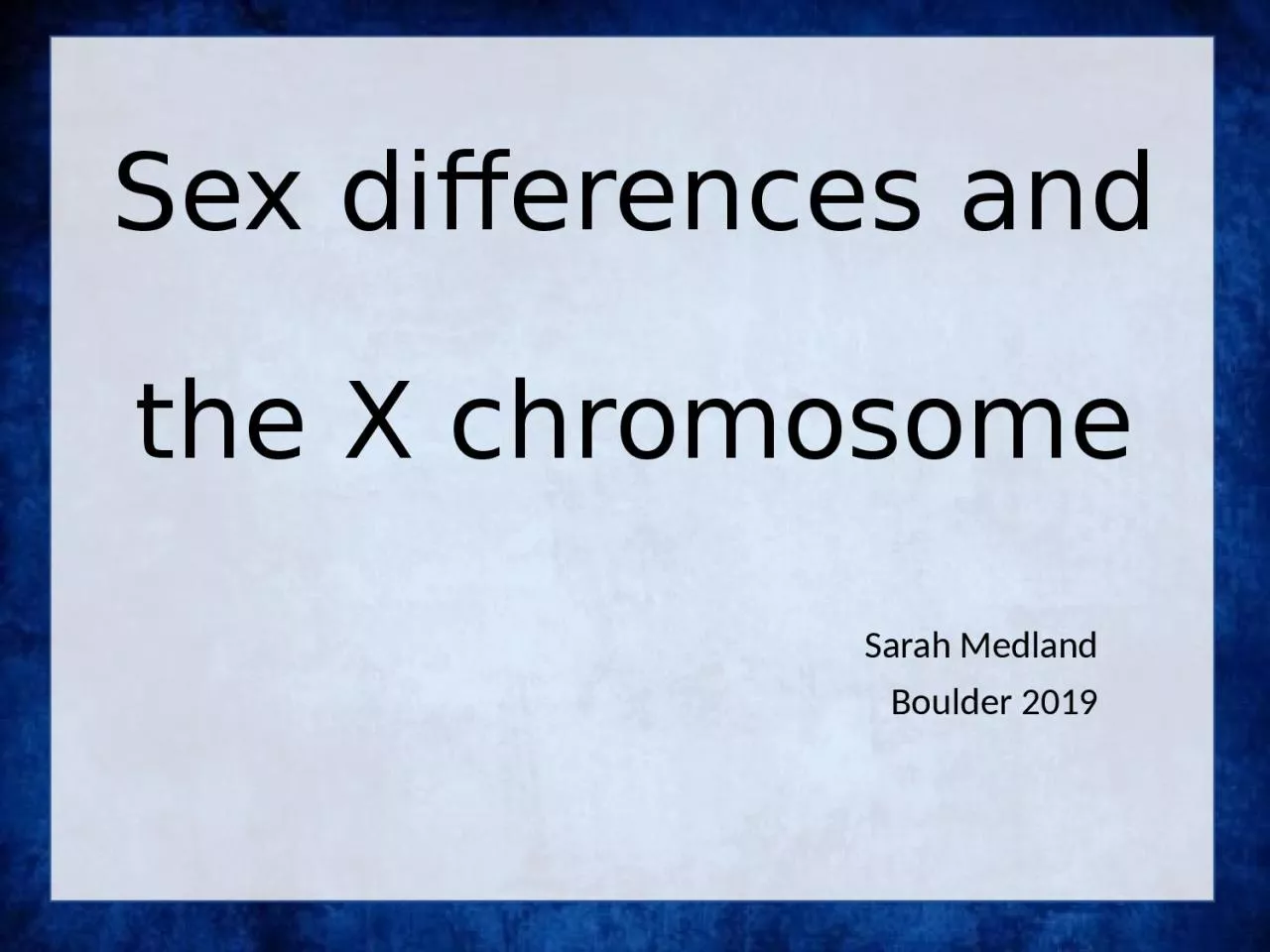

Sarah Medland Boulder 2019 Thinking about sex differences using the language of heterogeneity Are these differences due to differences in the magnitude of the effects quantitative eg Is the contribution of genetic effects greatersmaller in males than in females ID: 915399
Download Presentation The PPT/PDF document "Sex differences and the X chromosome" is the property of its rightful owner. Permission is granted to download and print the materials on this web site for personal, non-commercial use only, and to display it on your personal computer provided you do not modify the materials and that you retain all copyright notices contained in the materials. By downloading content from our website, you accept the terms of this agreement.
Slide1
Sex differences and the X chromosome
Sarah Medland
Boulder 2019
Slide2Thinking about sex differences using the language of heterogeneity
Are these differences due to differences in the magnitude of the effects (quantitative)?
e.g. Is the contribution of genetic effects greater/smaller in males than in females?
Are the differences due to differences in the source/nature of the effects (qualitative)?
e.g. Are there different genetic effect influencing the trait in males and females?
Slide3The language of heterogeneity
Sex differences = Sex limitation
1948
1861
1840
Slide4The language of heterogeneity
Quantitative
-
differences in the magnitude of the effects
Qualitative
-
differences in the source/nature of the effects
Models
Scalar
Models
Non-scalar
Slide5The language of heterogeneityScalar limitation (Quantitative)
% of variance due to A,C,E are the same between groups
The total variance is not
ie
:
var
Female = k*varMaleAFemale = k*A
MaleEFemale = k*EMale
k here is the scalar
Slide6The language of heterogeneity
Non-Scalar limitation
var
Female
≠
varMaleAFemale ≠ AMale
EFemale ≠ EMale
Slide7Slide8Slide9How can we test for this in a GWAS?
Check for sex differences the phenotypic distributions or frequencies
Check for interactions between SNP effects and sex
Make sure you include a main effect of sex when you do this
Plink 1.9 – include sex in the
cov
file and request main effects and interactionsplink --
bfile mydata --linear interaction --covar
my.cov --sex
Slide10Other ways of doing this?
Slide111df
1df
2df
1df
1df
Implementation in the GWASMA software package
Slide12Slide13Slide14Slide15What about X?
Slide16Slide17Let’s fact check this
GWAS catalogue
https://www.ebi.ac.uk/gwas/
Slide18As of 2019-01-31, the GWAS Catalog
contains 3764 publications and 107785 unique SNP-trait associations.
537 of these associations (0.5%) are on the X chromosome
2 are on the Y chromosome
Slide19Why is this is case?
Slide202 points here
Coverage on chips
Still a major issue
Many annotation errors
Modelling of X effects
X Inactivation
Dosage compensation
Slide21A critical 3rd point
HapMap2 never
released X references
for imputation
Slide22Dosage compensation
Dosage compensation is the process by which organisms equalize the expression of genes between members of different biological sexes
Different species have different methods
Random inactivation of one
♀
X (
eg mammals)not all genes along the X chromosome are subject to X-inactivation
active expression at some loci is required for homologous recombination with the pseudo-autosomal region (PAR) of the Y chromosome during meiosis10-25% of human X chromosome genes outside of the PARs show weak expression from the inactive X chromosome. Two-fold increased transcription of a single ♂ X (
eg Drosophila)Decreased transcription of both hermaphroditic Xs by half (eg C. elegans)
Slide23X inactivation (the canonical version)
the inactive chromosome is silenced through methylation
Slide24X inactivation (the canonical version)
In humans inactivation happens during the l
ate blastocyst stage, after implantation.
It is theoretically random and inherited by the daughter cells
Slide25What this means analytically
The variance of females for expression/effect of X linked variants will be ½ that of males
Using a test designed for autosomes will not account for this properly
To the extent that X has a substantial effect on a phenotype you are analysing you might expect to see
Var
MALE
> VarFEMALE
Slide26Implications for QC & Type I error
Slide27How can we analyse X properly?
Slide28P, G, and S stand for phenotype, genotype, and sex
Slide29Slide30Slide31Slide32My reading of this is these are currently the best models
G1S = plink --
bfile
mydata
--linear --
xchr
-model 1 --covar
mydata.cov --out Xchromosome
G2S = plink --
bfile
mydata --linear --xchr-model 2 --covar
mydata.cov
--out
Xchromosome
Slide33Other software to think about
Slide34A last word on the topic